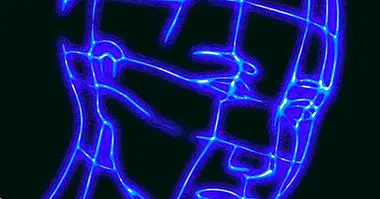Personality Limit Disorder (BPD): Causes, Symptoms and Treatment
The Borderline personality disorder or TLP It is considered one of the most serious personality disorders, along with the Paranoid Personality Disorder and the Schizotypal Disorder, since many experts think of them as more accentuated versions of the rest.
In that sense, the TLP can share many characteristics with others personality disorders , as the dependent, the histrionic, the avoidant or the antisocial.
Borderline personality disorder
Key signals for the diagnosis of BPD
The diagnostic criteria of the DSM include:
- Frenzied efforts to avoid abandonment, real or imaginary;
- Alternation between extremes of idealization and devaluation in interpersonal relationships;
- Markedly unstable self-image;
- Potentially dangerous impulsivity, for example in relation to money, sex, substance abuse or binge eating;
- Self-harm or threats or suicide attempts;
- Instability in the mood due to a marked emotional reactivity;
- Chronic feelings of emptiness;
- Intense and inappropriate anger or difficulty controlling anger;
- Paranoid ideation or severe dissociative symptoms, transient and related to stress.
The causes of Personality Limit Disorder
It is currently believed that Personality Disorder is the result of the combination between the biological predisposition to feel a high emotional reactivity , which would lead to particularly frequent and intense episodes of impulsivity or irritability, and an invalidating environment.
Marsha Linehan, creator of this concept and expert in the Personality Disorder, defines the invalidating environment as one in which the caregivers project their own emotions and motivations in the child instead of recognizing and approving the latter, not tolerating the samples of negative emotions. In this way, the child's analysis of his experiences would be trivialized (for example, by saying "You are angry but you do not want to admit it") and it would be conveyed to him that these are caused by personality traits that are qualified as negative, which is I would summarize in messages like "You're bad". Without proper validation of one's own experiences, the child can not learn to correctly label their emotions or to consider their reactions to be natural, which hinders the development of identity.
The Personality Limit Disorder It has also been frequently associated with childhood traumas ; Among the risk factors for the development of the disorder are neglect and emotional abuse, witnessing domestic violence, criminality and substance abuse by parents and, in particular, repeated sexual abuse. It has been hypothesized that this type of chronic victimization would lead the child to believe that he is vulnerable and impotent and others are dangerous and, therefore, would affect his ability to form secure and satisfying attachment links.
According to Pretzer (1996), people with Borderline Personality Disorder conceive the world in dichotomous terms, that is, their opinions about themselves, the world and the future tend to be completely positive or completely negative. This way of thinking would lead to emotions always intense and rapidly changing from one extreme to the other, without the possibility of medium terms. As a natural consequence, others perceive these changes as irrational and random.
The tendency of people with Borderline Personality Disorder to feel negative emotions more intensely and frequently than most people partly explains their propensity to use drugs , binge eating - and therefore bulimia nervosa - or risky sexual relationships. All these behaviors are carried out with the intention of reducing the discomfort, as also happens sometimes with self-injurious behaviors, which are used to temporarily divert attention from negative emotions. Many people with Borderline Personality Disorder who carry out this type of behavior claim that they feel little or no pain during these episodes, most frequent between 18 and 24 years.
BPD and emotional dependence
The self-devaluation inherent to the Personality Disorder is related to the intense need to have an intimate relationship with another person, be it romantic or not . These relationships reduce the feelings of emptiness and lack of personal value and make the person with Borderline Personality Disorder feel protected in a world that, as has been said, conceives as dangerous.Since their need to be united to the significant other is so strong, it is not surprising that people with Borderline Personality Disorder are extremely sensitive to the possibility of being abandoned; Banal acts of others are often interpreted as signs of imminent abandonment.
Thus, not only frequent outbursts of despair and anger against others occur, but self-injurious behaviors can be used as attempts to manipulate others so that they do not leave them or as a form of revenge if they feel they have been abandoned . The symptoms of BPD tend to decrease with age, including self-injurious behaviors. However, in older people these may manifest themselves in somewhat different ways, such as by neglecting the diet or pharmacological treatments.
Nevertheless, and paradoxically, the strong union with the other can also lead to the fear that one's identity, fragile and unstable, will be absorbed. It is also feared that the abandonment perceived as inevitable is more painful the more intimate the relationship. This is why the chaotic interpersonal behavior of people with Borderline Personality Disorder can in some way be considered an unconscious strategy to avoid a stability that can be feared as much as feelings of emptiness. In this way, Many people with BPD fluctuate between fear of loneliness and the fear of dependence, maintaining their relationships for a time in an unstable and pathological balance. Others, feeling frustrated and exasperated, tend to turn away from them, which reinforces their belief that they deserve to be abandoned, forming a vicious circle in which the person with BPD causes the very thing that they fear will happen.
The BPD and depression
The TLP involves a strong predisposition to depressive episodes , because it is related to low self-esteem, feelings of guilt, despair and hostility toward others. In fact, some experts claim that the TLP could be considered a mood disorder , and the emotional instability characteristic of BPD has even been related to bipolar disorder, which is defined by the alternation between periods of weeks or months of depression and others of pathologically elevated mood.
Possible treatments for Borderline Disorder
It is probably the severity of the Personality Disorder which has led to more research about its treatment than about any other personality disorder, so that currently it is the only one for which a treatment is known. effective. We refer to the Dialectical Behavior Therapy, devised in the 90s by the aforementioned Linehan (1993), who, to the surprise of the scientific community, recently revealed that she herself was diagnosed with BPD.
The Dialectic Behavior Therapy it is based on the apparent paradox that, according to Linehan, led her to improve and motivated her to develop her therapy: in order to change, radical acceptance of oneself is necessary. Among other strategies, this treatment includes strategies for emotional regulation , training in social skills and belief modification.
Bibliographic references:
- Carey, B. Expert on Mental Illness Reveals Her Own Fight. The New York Times Online. June 23, 2011. Retrieved from //www.nytimes.com/2011/06/23/health/23lives.h ...
- Linehan, M. M. (1993). Cognitive-behavioral therapy of borderline personality disorder New York: Guilford Press.
- Millon, T .; Grossman, S .; Millon, C .; Meagher, S .; Ramnath, R. (2004). Personality disorders in modern life, 2nd Ed (pp. 493-535). Hoboken, New Jersey: John Wiley & Sons.
- Pretzer, J. L. & Beck, A. T. (1996). A cognitive theory of personality disorders. In J. F. Clarkin & M. F. Lenzenweger (Eds.), Major theories of personality disorder (pp. 36-105). New York: Guilford Press.
- Stone, M. H. (1981). Borderline syndromes: A consideration of subtypes and an overview, directions for research. Psychiatric Clinics of North America, 4, 3-24.



















